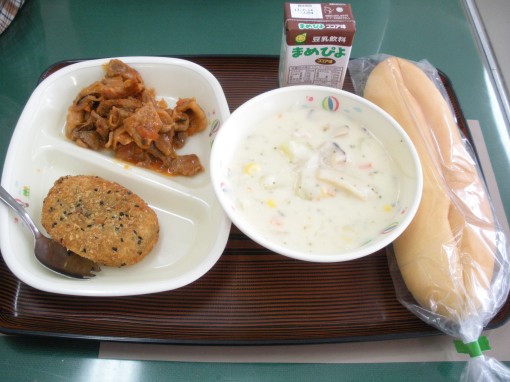June 25th, Monday:

- Midakusan Soup (Sweet Potato, Tofu, Sliced Konnyaku, Carrot, Onion, Burdock)
- Simmered Minced Meat and Daikon (Daikon Radish, Pork, Edamame)
- Eel-Style Simmered Saury
- Rice
- Milk
The saury catch increases in Autumn. The saury we use in this season are frozen. It is an easy to use ingredient due to it’s stable price. It was cooked kabayaki(eel)-style with a sauce made of shoyu and mirin.
I can’t say that the daikon soboro is my favourite. It isn’t bad, but neither is it very good, in my ignorant opinion. There are fish I like more than saury, but today’s eel-style cooked saury was pretty popular among the boys in my class today. Thus soup (unsurpisingly) was my favorite dish today, although it was strangly onion-y.
A year or so ago, one of my teacher’s gave the students some free time–like five or ten minutes–at the end of class. They could work on homework or even talk with their friends, but she said they shouldn’t read in class. This struck me as peculiar.
When I was in school, students failing to read was considered a problem. Thus we had lots of programs put in place in order to encourage kids to read more. The one I most fondly recall was where you got stickers for reading a certain amount and when you collected enough stickers, you could get a free personal pizza. Going out to eat was something reserved for special occasions, so going out for pizza merely for reading was pretty awesome. But my point is, that I was raised with the idea that any form of reading ought to be encouraged, but here in Japan I was encountering the idea that reading is a frivilous activtiy not always allowed. (To be fair, the lack of children reading is becoming more of a problem now in Japan, and very few teachers are strict about not reading during down time in class.)
Why is there the idea that reading is frivilous in Japan? I can think of two reasons. The first is that reading is still fun for most Japanese children. There are a wide variety of books: manga, illustrated novels, sports-based novels, etc. that lower the barrier to reading for lower-level students. The second reason is historically Japan has distinguished between frivilous reading (ie: worthless novels &c.) and serious reading (ie: the classics, moral biographies &c.)
Speaking of historical Japan and reading, Edo period Japan had a higher literacy rate than the Western nations. Thus it is interesting that all the Edo/Meiji period novels I own (which is several), are written largely in kanji all accompanied by furigana. These are popular novels: tales of the supernatural, or tales of love and revenge. Equivalent modern books rarely use furigana and use hiragana rather than the more difficult kanji. I think this is a shame. Not only does a fully glossed text allow the less educated to enjoy reading the book, but it adds a fuller meaning to the text. 握飯 (nigirimeshi) alone only means some rice in a ball. For example, お握飯 glossed as “omusubi” gives it a fuller meaning: more colloquial, slightly soft feeling. And there were many such instances as this. I feel this kanji with furigana glosses method allows the text to be read at two levels: both meaning and phonetically. (If you aren’t convinced, consider how Motowori glossed the Kojiki. Definitely two levels.) It is a shame it is hardly used any more.
- みだくさん汁
- 大根のそぼろ煮
- さんまの蒲焼風煮
- ごはん
- 牛乳







